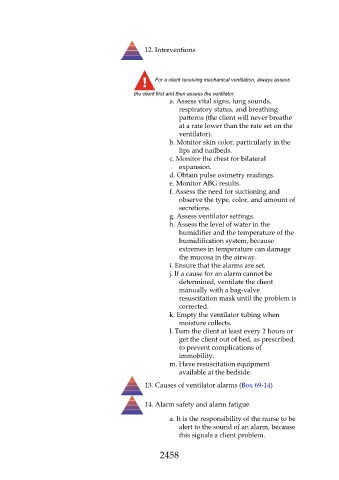Page 2458 - Saunders Comprehensive Review For NCLEX-RN
P. 2458
12. Interventions
For a client receiving mechanical ventilation, always assess
the client first and then assess the ventilator.
a. Assess vital signs, lung sounds,
respiratory status, and breathing
patterns (the client will never breathe
at a rate lower than the rate set on the
ventilator).
b. Monitor skin color, particularly in the
lips and nailbeds.
c. Monitor the chest for bilateral
expansion.
d. Obtain pulse oximetry readings.
e. Monitor ABG results.
f. Assess the need for suctioning and
observe the type, color, and amount of
secretions.
g. Assess ventilator settings.
h. Assess the level of water in the
humidifier and the temperature of the
humidification system, because
extremes in temperature can damage
the mucosa in the airway.
i. Ensure that the alarms are set.
j. If a cause for an alarm cannot be
determined, ventilate the client
manually with a bag-valve
resuscitation mask until the problem is
corrected.
k. Empty the ventilator tubing when
moisture collects.
l. Turn the client at least every 2 hours or
get the client out of bed, as prescribed,
to prevent complications of
immobility.
m. Have resuscitation equipment
available at the bedside.
13. Causes of ventilator alarms (Box 69-14)
14. Alarm safety and alarm fatigue
a. It is the responsibility of the nurse to be
alert to the sound of an alarm, because
this signals a client problem.
2458

